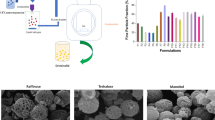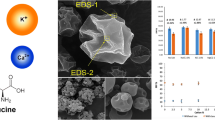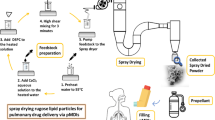Abstract
Aim of this study was to elaborate an efficient method for the micronization of the decapeptide cetrorelix (a GnRH-antagonist), in order to obtain a microsuspension as basis for other pharmaceutical preparations, such as e.g. inhalation aerosols. A modified pearl-mill coupled with a cryostat was used for the micronization of cetrorelix in fluid propellant and operated under different conditions. The obtained cetrorelix suspensions were analyzed for particle size distribution, purity of cetrorelix, and for metal contamination through abrasion from parts of the mill. The method allowed an effective micronization of cetrorelix. The mean particle size of the initial cetrorelix lyophilizate bulk ware was reduced from 52.5 μ (Volume Mean Diameter, VMD) down to 14.9, 6.1 and 3.1 μm, respectively, respectively. The HPLC analysis of all cetrorelix suspensions after micronization did not show signs of decomposition as compared to the initial product. The elementary analysis of the suspensions performed by inductively coupled plasma mass spectrometry revealed a negligible amount of contaminants in the suspension (Zr=max. 0.6 ppm; Fe, Cr, Ni, Ba, below limit of quantification, i.e.<0.14 ppm). The only appreciable contaminant. Aluminum (Al=1.1 ppm), was derived from the mechanical capping of aluminum canisters prior to analysis. The Zr determination in the suspension of 0.6 ppm, is still considered to be negligible as compared to the legally tolerated limit of air contamination. By low-temperature micronization in fluid propellant, fine drug suspensions of cetrorelix for pMDIs can be directly manufactured in one-step procedure without destruction of the peptide structure and without appreciable product contamination.
Similar content being viewed by others
References
MacKellear A, Osborne N. Breathing new life into drug delivery. Manufacturing Chemist. 1998;8:31–33.
Maa Y-F, Nguyen P-A, Sweeney T, Shire SJ, Hsu CC. Protein inhalation powders: spray drying vs freeze drying. Pharm Sci. 1999;16:249–254.
Banga AK. Therapeutic peptides and proteins, formulation, processing, and delivery systems. Basel. Switzerland: Technomic Publishing Co, Inc.; 1996.
Adjei AL, Kesterson JW, Johnson ES inventors, LHRH analog formulation European patent application public number 051073 1A1. 1987.
Adjei AL, Johnson ES, Kesterson JW. inventors. LHRH analog formulation. US patent 4 897 256. January 30. 1990.
US Pharmacopeial Convention, Inc.The United States Pharmacopeia. 23rd ed. Rockville, MD: US Pharmacopeial Convention, Inc.; 1995.
Niven RW. Delivery of biotherapeutics by inhalation aerosol. Critical Rev Ther. Drug Carrier Sys. 1995;12:151–231.
Labrude P, Rasolomanana M, Vigneron C. Thirion C and Chaillot B, Protective effect of sucrose on spray drying of oxyhemoglobin. J. Pharm. Sci. 1989;78:223–9.
Stadler R, Polke R, Schwedes J, and Vock F. Naßmahlung in Rührwerksmühlen. Chem. Ing. Tech. 1990;62:907–915.
Winkler J and Getzmann H. Laboratory bead mill for research and development. Polymers Paint Colour Journal 1993;183:11–25.
Bundesministerium für Arbeit und Sozialordnung. Technische Regel für Gefahrstoffe 900 (TRGS 900): Grenzwerte in der Luft am Arbeitsplatz “Luftgrenzwerte,” Bundesarbeitsblatt (BarbBl.), Heft 10 1996, and supplements: BarbBl. 11/1997, S. 39: BarbBl. 5/1998, S. 63. BarbBl. 10/1998, S. 73.
Author information
Authors and Affiliations
Corresponding author
Additional information
Published: July 12, 2001.
Rights and permissions
About this article
Cite this article
Lizio, R., Damm, M., Sarlikiotis, A.W. et al. Low-temperature micronization of a peptide drug in fluid propellant: Case study cetrorelix. AAPS PharmSciTech 2, 12 (2001). https://doi.org/10.1208/pt020312
Received:
Accepted:
DOI: https://doi.org/10.1208/pt020312




